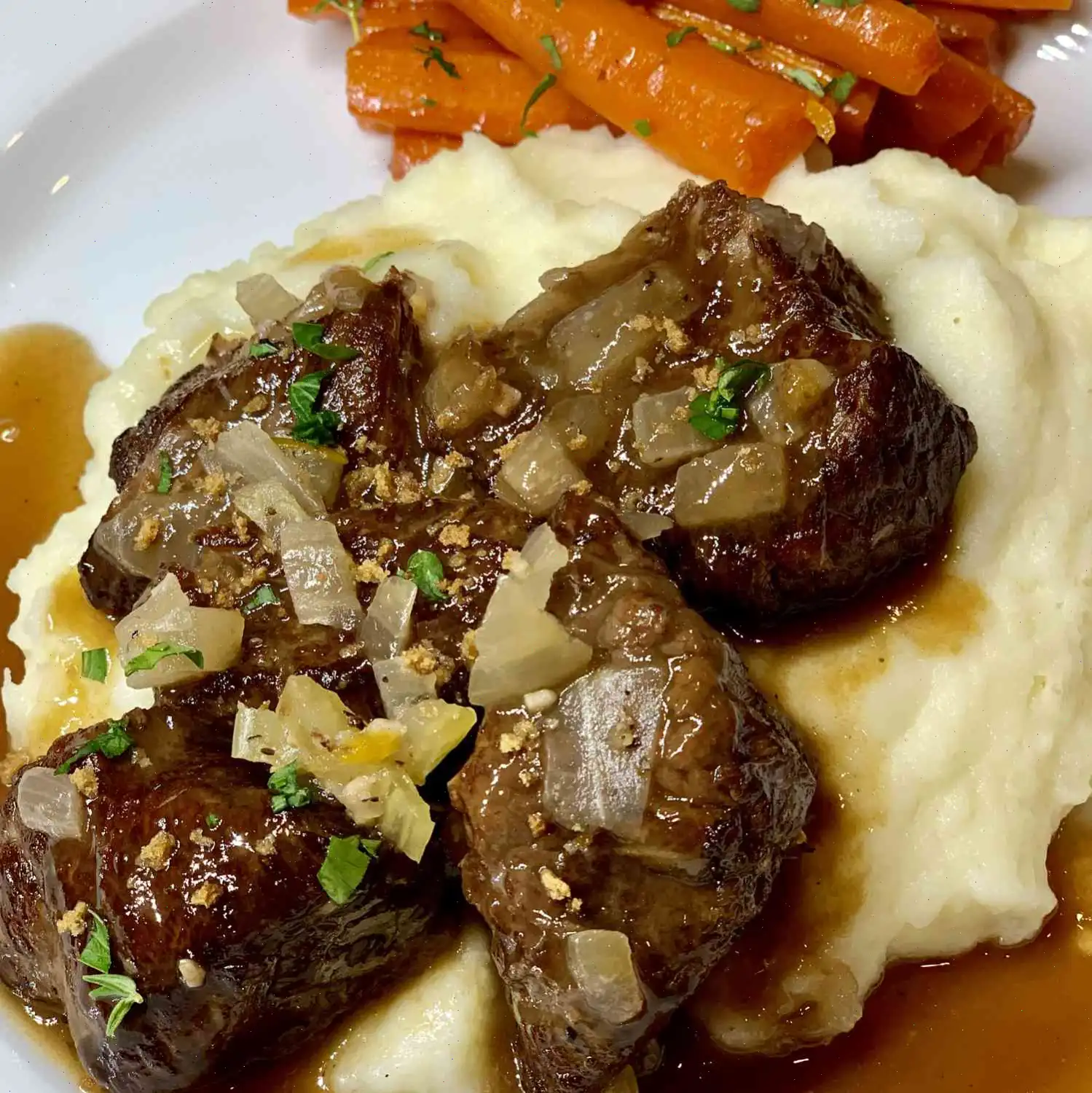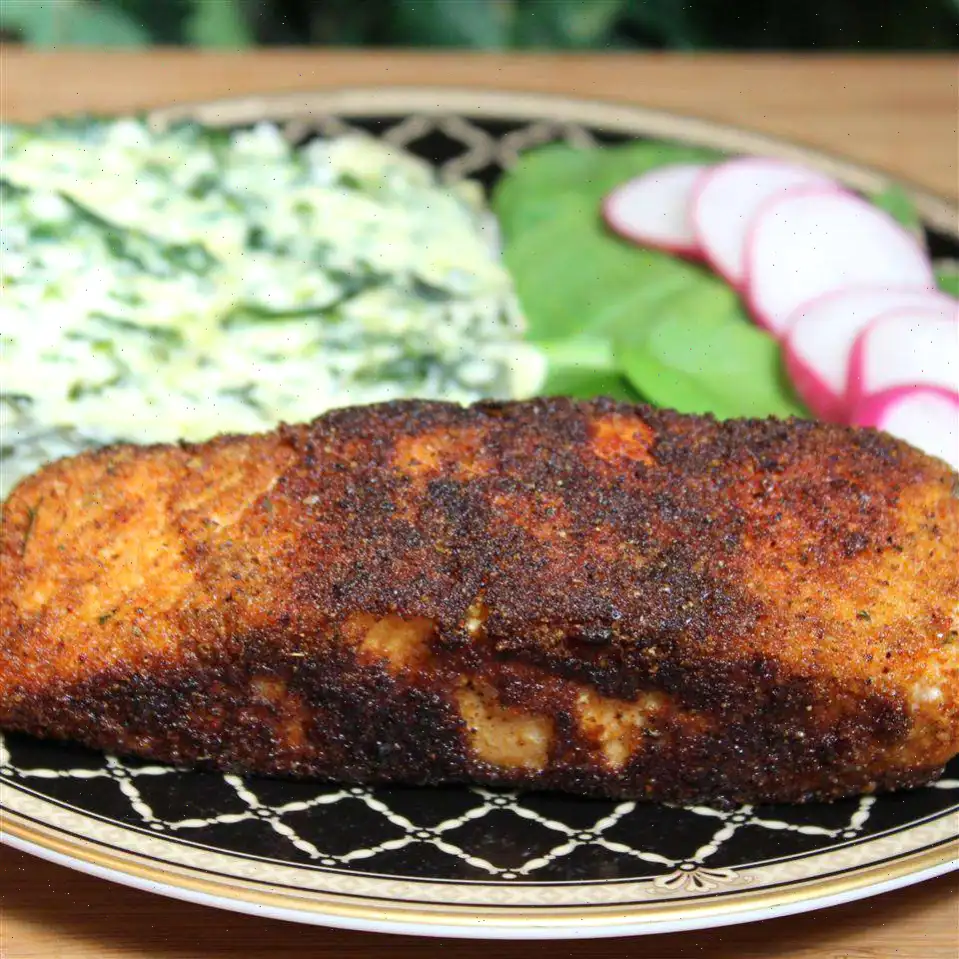
Beef Short Ribs Sauerbraten Recipe
Ingredients
- 3 pounds beef short ribs
- Salt and ground black pepper to taste
- 1 tablespoon vegetable oil
- 1 cups water
- cup cider vinegar
- cup red wine vinegar
- 12 juniper berries
- 9 whole cloves
- 2 bay leaves
- 1 tablespoon salt
- teaspoon freshly ground black pepper
- 1 cup cold water
- 2 tablespoons butter
- 1 large onion, chopped
- 2 stalks celery, chopped
- 1 carrot, chopped
- 3 cloves garlic, minced
- 1 cup water
- 1 cup chicken broth
- 2 tablespoons white sugar, or to taste
- cup crushed gingersnaps
- 1 tablespoon balsamic vinegar
- Salt and pepper to taste
Directions
Step 1: Season the beef short ribs on both sides with salt and black pepper.
Step 2: Heat vegetable oil in a heavy-bottomed skillet over medium-high heat. Cook the short ribs in batches, turning occasionally, until browned on all sides, about 10 minutes per batch. Once browned, transfer the short ribs to a large lidded plastic tub while preparing the marinade.
Step 3: In the same skillet, pour 1 cups of water, cider vinegar, and red wine vinegar. Bring the mixture to a simmer, scraping the browned bits off the bottom of the pan. Add the juniper berries, cloves, and bay leaves, and season with salt and black pepper.
Step 4: Remove the skillet from heat and pour in 1 cup of cold water. Stir, then pour the mixture over the ribs in the plastic tub. Place the tub in an ice bath for 30 to 40 minutes to chill. Once chilled, cover the tub and refrigerate the ribs to marinate for 24 hours.
Step 5: After the marination period, melt the butter in a large, heavy pot or Dutch oven over medium heat. Add the chopped onion, celery, and carrot to the pot. Cook, stirring occasionally, until the vegetables have softened, about 10 minutes. Add the minced garlic and cook for an additional minute.
Step 6: Place the marinated short ribs over the softened vegetables in the pot. Pour in the remaining marinade from the plastic tub, then add 1 cup of water, chicken broth, and white sugar. Stir to combine and bring the mixture to a simmer over medium-high heat.
Step 7: Reduce the heat to low and cover the pot. Let the mixture simmer gently for 3 to 4 hours, or until the meat is fork-tender.
Step 8: Once the short ribs are tender, remove the meat from the pot and place it on a serving platter. Discard the juniper berries, cloves, and bay leaves. Spoon the cooked onion mixture over the top of the ribs, reserving the excess cooking liquid in the pot.
Step 9: Place the pot with the remaining cooking liquid back over medium-high heat. Use a food processor to grind the gingersnaps into a fine powder, then add it to the cooking liquid. Stir in balsamic vinegar and let the mixture boil until it reduces and thickens, about 20 minutes. Skim off any excess fat during the reduction process. Season the sauce with salt to taste.
Step 10: Strain the gravy through a fine mesh sieve to remove any solids, then spoon the thickened sauce over the beef. Serve and enjoy!
Nutrition Facts (per serving)
- Calories: 626
- Total Fat: 50g (64% Daily Value)
- Saturated Fat: 21g (105% Daily Value)
- Cholesterol: 104mg (35% Daily Value)
- Sodium: 1459mg (63% Daily Value)
- Total Carbohydrate: 18g (7% Daily Value)
- Dietary Fiber: 2g (7% Daily Value)
- Total Sugars: 10g
- Protein: 23g (45% Daily Value)
- Vitamin C: 3mg (3% Daily Value)
- Calcium: 47mg (4% Daily Value)
- Iron: 3mg (17% Daily Value)
- Potassium: 363mg (8% Daily Value)
* Percent Daily Values are based on a 2,000-calorie diet. Your daily values may be higher or lower depending on your calorie needs. Nutrient information is not available for all ingredients. Consult a doctor or dietitian if following a medically restrictive diet.
Beef Short Ribs Sauerbraten is a traditional German dish that has stood the test of time, offering a rich, flavorful experience that perfectly combines savory and tangy tastes. It is a hearty meal that is perfect for a family dinner or a special occasion. In this article, we explore the origins of this dish, its regional variations, and interesting facts that make it truly unique.
History and Origins of Sauerbraten
Sauerbraten, meaning "sour roast," has its roots in Germany, where it was first created as a way to preserve meat before refrigeration. The practice of marinating meat in a vinegar-based solution allowed it to be tenderized and flavored, which was essential for long-lasting meals. The dish became widely popular in the 19th century and was often served during festive occasions such as holidays and family gatherings. Over time, it spread to other parts of Europe, particularly to the United States, through German immigrants. Today, Sauerbraten is considered a comfort food in many German households, often made with various cuts of beef, pork, or even mutton.
Regional Variations of Sauerbraten
While Sauerbraten is a German classic, its preparation varies across regions. In northern Germany, it is typically made with beef or pork, marinated in a mixture of vinegar and wine, while in southwestern Germany, the dish often features a thicker, sweeter gravy, sometimes incorporating gingerbread cookies or gingersnaps to thicken and flavor the sauce. The use of juniper berries is common throughout Germany, as these aromatic berries add a distinctive piney note to the marinade. Other regions, such as the Rhineland, may include raisins and a more robust flavor profile, while in Franconia, Sauerbraten is made with a touch of red wine for added depth.
How It Differs from Similar Dishes
At first glance, Sauerbraten may seem similar to other slow-cooked meat dishes, such as pot roast. However, what truly sets Sauerbraten apart is its distinctive marination process and the use of vinegar. While pot roast relies on dry roasting in an oven, Sauerbraten requires the meat to be marinated for at least 24 hours, allowing the acidic vinegar to tenderize the beef and impart a tangy flavor. Additionally, the use of aromatic spices like juniper berries, cloves, and bay leaves, combined with the sweetness of gingersnaps, creates a flavor profile that is unique to Sauerbraten.
Where Sauerbraten Is Traditionally Served
Sauerbraten is traditionally served in German homes, especially during the colder months, as it is a hearty, warming dish. It is often enjoyed with sides such as mashed potatoes, red cabbage, or dumplings. In Germany, it is also commonly served at family gatherings, festive occasions, and special dinners. It has become a beloved dish in German-American communities, particularly in areas with large German populations, like Pennsylvania and parts of the Midwest. In fact, you can find Sauerbraten on the menu in many German restaurants around the world, where it remains a favorite of those seeking a taste of authentic German comfort food.
Interesting Facts About Sauerbraten
1. Vinegar as Tenderizer: The key ingredient in Sauerbraten's marinade is vinegar. This acidic liquid not only adds a tangy flavor but also works as a natural tenderizer, breaking down the tough fibers of the meat for a more succulent result.
2. Regional Variations: As mentioned, Sauerbraten differs from region to region in Germany. In some areas, it is served with a sweet and sour gravy, while in others, the addition of red wine or raisins gives it a richer, sweeter flavor.
3. Gingersnaps in the Gravy: One of the unique features of Sauerbraten is the use of crushed gingersnaps in the gravy. These cookies thicken the sauce and add a subtle sweetness and spice that complements the tangy marinade perfectly.
4. Time-Intensive Preparation: Although Sauerbraten requires a long marination timeusually 24 to 48 hoursit is well worth the wait. The slow cooking process results in melt-in-your-mouth tender meat that absorbs all the flavors from the marinade and spices.
Conclusion
Beef Short Ribs Sauerbraten is a dish that tells the story of German culinary tradition and the ingenuity of using simple ingredients to create complex flavors. Whether served in a cozy home or at a festive gathering, Sauerbraten remains a symbol of comfort and family bonding. Its unique preparation method, regional variations, and historical significance make it a dish worth trying and savoring.
FAQ about Beef Short Ribs Sauerbraten Recipe
Comments
Nathan Smith
03/18/2025 02:23:45 AM
Delicious and fulfilling! I kept the recipe the same but switched up my cooking equipment. I seared the ribs in a cast iron skillet and used the same skillet to prepare the marinade. After marinating for over 24 hours, I utilized my Instant Pot: I sautéed the onion mixture using the sauté function, slow-cooked the meat for 4 hours, and then used the sauté function again to create the sauce/gravy.
Jeffrey Mitchell
03/05/2025 01:44:49 PM
Outstanding! A restaurant in Frankenmuth, MI served an outstanding sauerbraten, and this recipe is just as good, if not better! I will be sure to recommend it to all my friends and family and am eager to make it again. I followed the instructions exactly, except I used chuck roast and couldn't find juniper. Huge thanks to Chef John!
Gregory Rodriguez
01/24/2025 05:45:27 PM
I have fond memories of eating sauerbraten since childhood, and this dish tasted just like my mom used to make. If I can also find a recipe for raw potato balls, I'll be in culinary heaven!
Stephen Jones
02/19/2023 04:48:25 PM
Fairly straightforward to prepare. Served with herbed spaetzle. Ensure you have proper ventilation in your kitchen as the vinegar at the start may be a bit potent as it simmers. It requires some preliminary planning and cooking, but it is simple to complete the dish on the day with just a quick 15-minute sauce reduction. Ended up being a success for a holiday dinner with a German-American theme that the family thoroughly enjoyed.
Julie Williams
01/30/2025 05:19:35 AM
I tried out this recipe today and wanted to say thank you for sharing it. It turned out absolutely fantastic!








